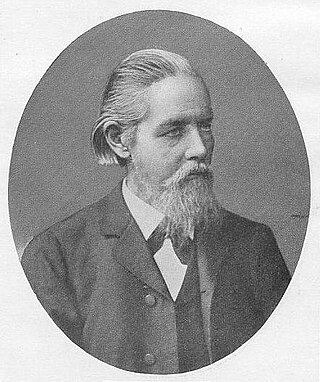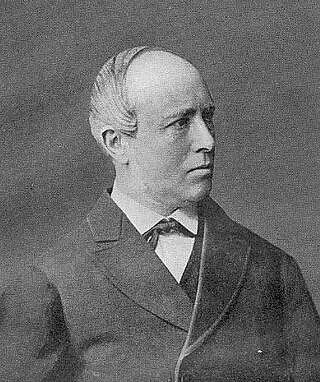Related Research Articles

Friedrich Blass was a German classical scholar.
In linguistics, the Indo-European ablaut is a system of apophony in the Proto-Indo-European language (PIE).
In Indo-European studies, a thematic vowel or theme vowel is the vowel *e or *o from ablaut placed before the ending of a Proto-Indo-European (PIE) word. Nouns, adjectives, and verbs in the Indo-European languages with this vowel are thematic, and those without it are athematic. Used more generally, a thematic vowel is any vowel found at the end of the stem of a word.

Georg Curtius was a German philologist and distinguished comparativist.
Proto-Indo-European (PIE) is the reconstructed common ancestor of the Indo-European language family. No direct record of Proto-Indo-European exists; its proposed features have been derived by linguistic reconstruction from documented Indo-European languages.
The perfective aspect, sometimes called the aoristic aspect, is a grammatical aspect that describes an action viewed as a simple whole, i.e., a unit without interior composition. The perfective aspect is distinguished from the imperfective aspect, which presents an event as having internal structure. The term perfective should be distinguished from perfect.
Proto-Indo-European verbs reflect a complex system of morphology, more complicated than the substantive, with verbs categorized according to their aspect, using multiple grammatical moods and voices, and being conjugated according to person, number and tense. In addition to finite forms thus formed, non-finite forms such as participles are also extensively used.
Proto-Celtic, or Common Celtic, is the hypothetical ancestral proto-language of all known Celtic languages, and a descendant of Proto-Indo-European. It is not attested in writing but has been partly reconstructed through the comparative method. Proto-Celtic is generally thought to have been spoken between 1300 and 800 BC, after which it began to split into different languages. Proto-Celtic is often associated with the Urnfield culture and particularly with the Hallstatt culture. Celtic languages share common features with Italic languages that are not found in other branches of Indo-European, suggesting the possibility of an earlier Italo-Celtic linguistic unity.

Jacob WackernagelGerman:[ˈvakərˌnaːɡəl] was a Swiss linguist, Indo-Europeanist and scholar of Sanskrit. He was born in Basel, son of the philologist Wilhelm Wackernagel (1806–1869).
An inchoative verb, sometimes called an "inceptive" verb, shows a process of beginning or becoming. Productive inchoative affixes exist in several languages, including the suffixes present in Latin and Ancient Greek, and consequently some Romance languages. Not all verbs with inchoative suffixes have retained their inceptive meaning. In Italian, for example, present indicative finisco 'I finish' contains the form of the suffix, while present indicative finiamo 'we finish' does not, yet the only difference in meaning is that of person subject; the suffix is now semantically inert.
Brugmann's law, named for Karl Brugmann, is a sound law stating that in the Indo-Iranian languages, the earlier Proto-Indo-European *o normally became *a in Proto-Indo-Iranian but *ā in open syllables if it was followed by one consonant and another vowel. For example, the Proto-Indo-European noun for 'wood' was *dόru, which in Vedic became dāru. Everywhere else, the outcome was *a, the same as the reflexes of PIE *e and *a.

Hindustani, the lingua franca of Northern India and Pakistan, has two standardised registers: Hindi and Urdu. Grammatical differences between the two standards are minor but each uses its own script: Hindi uses Devanagari while Urdu uses an extended form of the Perso-Arabic script, typically in the Nastaʿlīq style.
Raphael Kühner was a German classical scholar.
The phonology of the Proto-Indo-European language (PIE) has been reconstructed by linguists, based on the similarities and differences among current and extinct Indo-European languages. Because PIE was not written, linguists must rely on the evidence of its earliest attested descendants, such as Hittite, Sanskrit, Ancient Greek, and Latin, to reconstruct its phonology.
The roots of the reconstructed Proto-Indo-European language (PIE) are basic parts of words to carry a lexical meaning, so-called morphemes. PIE roots usually have verbal meaning like "to eat" or "to run". Roots never occurred alone in the language. Complete inflected verbs, nouns, and adjectives were formed by adding further morphemes to a root and potentially changing the root's vowel in a process called ablaut.
Sanskrit has inherited from its parent, the Proto-Indo-European language, an elaborate system of verbal morphology, much of which has been preserved in Sanskrit as a whole, unlike in other kindred languages, such as Ancient Greek or Latin. Sanskrit verbs thus have an inflection system for different combinations of tense, aspect, mood, voice, number, and person. Non-finite forms such as participles are also extensively used.
Vedic Sanskrit is the name given by modern scholarship to the oldest attested descendant of the Proto-Indo-Aryan language. This is the language that was used in the religious hymns known as the four Vedas, in particular, the Rigveda, the oldest of them, dated to have been composed roughly over the period from 1500 to 1000 BCE. Before its standardization as Sanskrit, the Vedic language was a purely spoken language during that period used before the introduction of writing in the language.

Gothic is an extinct East Germanic language that was spoken by the Goths. It is known primarily from the Codex Argenteus, a 6th-century copy of a 4th-century Bible translation, and is the only East Germanic language with a sizeable text corpus. All others, including Burgundian and Vandalic, are known, if at all, only from proper names that survived in historical accounts, and from loanwords in other, mainly Romance, languages.

Friedrich Bernhard Gerth was a German educator and classical philologist.
Pure verbs, or vocalic verbs, are those verbs of the Greek language that have their word stem ending in a vowel.
References
- ↑ Curtius, Georg (1880). The Greek Verb: Its Structure and Development. Translated by Wilkins, Augustus S; England, E. B. London: J. Murray. pp. "The I Class", p. 201–227 sections 292–330.
- ↑ Curtius, Georg (1880). The Greek Verb: Its Structure and Development. Translated by Wilkins, Augustus S; England, E. B. London: J. Murray. pp. "The Inchoative Class", p. 187–200 sections 271–291.Vine, Brent (1993). "Greek -ίσκω and Indo-European "*-isk̑e/o-"". Historische Sprachforschung / Historical Linguistics. 106 (1): 49–60. JSTOR 40849080.